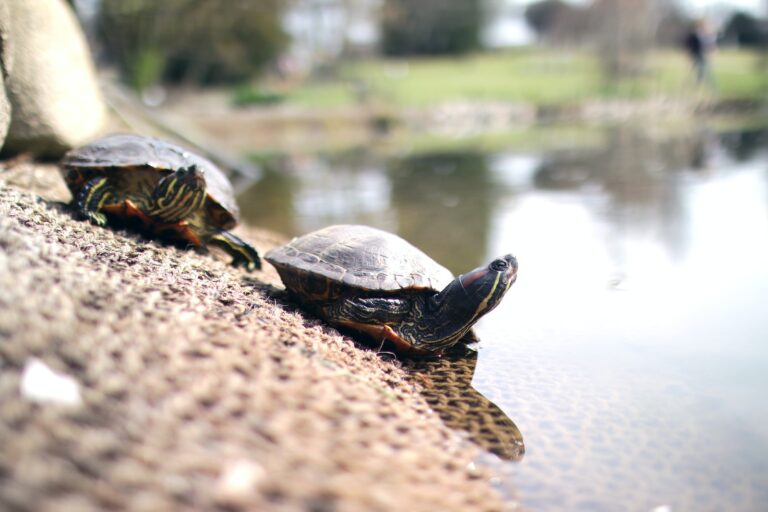When it comes to mating, turtles have a very complicated process. Aquatic turtles first meet underwater and if she is ready to mate, the male climbs on her back as she swims horizontally. He flutters his front claws around her face and strokes her neck and head.
The male then inserts semen into her cloaca, which is both an intestinal and reproductive organ. This can happen underwater or on the surface of the water.
Males mate with females
Many animals go to great lengths to mate. Males produce millions of sperm and can father lots of offspring, while females have to wait for the eggs to develop and then care for them until they are ready to be born. This means that the males need to attract choosy females, so they often make elaborate displays. These include bowers decorated with rocks, flowers and other objects. They also have special structures that act like a sex organ to pump out a stream of sperm. The females check out the display, choosing a male based on his performance.
Males with more display experience have higher courtship rates and fewer errors, which means that they are likely to be preferred by females. The authors of the study suggest that this leads to multiple paternity, because a female may choose an inexperienced sire at first and then later decide to mate with a better performer.
In addition, a single male can produce more eggs than one female can, which means that he can compete with other males for fertilized eggs. This competition is reflected in sexual selection, as measured by the Bateman gradient. A wide range of animals, from beetles to mammals, have high Bateman gradients. However, it is important to note that these gradients are not necessarily caused by competition for fertilized eggs. They could be caused by the fact that females spend a lot of energy making each egg, while males only have to make sperm.
Females mate with other females
While male-male competition is often a focus of sexual selection research, there are many species in which females actively choose their mates. These selections are often maintained by benefits to the female’s own survival and breeding success or by generating benefits for her offspring. Female mate preferences are often highly variable, however. This is perhaps because it’s challenging to determine the traits that are most important.
One hypothesis is that females choose a male with specific phenotypic characteristics that reflect her quality or fitness. This theory is supported by studies of green tree frogs, guppies, and mallard ducks that demonstrate that females prefer a male’s secondary sexual characteristics. Another hypothesis is that females choose a male on the basis of his courtship displays. This theory is supported by studies of lekking birds, such as barn swallows (Hirundo rustica). For example, females prefer males with elongated tail feathers. This feature is thought to protect against bloodsucking parasites.
Other research suggests that females choose a male based on his display vigour or skill. This theory is supported by a number of studies, including those of a lekking ruff (Claudetius galicus) and the genus Xiphophorus. A key prediction of this hypothesis is that males with greater display experience are able to produce more consistent displays than those with less experience. Rivers and DuVal argue that females may use this information to select a high-status, higher-displaying male.
Males mate with other males
A number of animal species are characterized by alternative mating tactics (AMTs) that differ in behaviour, morphology and life history. These differences may have direct effects on female fitness, for example in a case of the puffer fish where males use different tactics to attract females to their lairs. Some of these differences may be genetic, while others are likely influenced by environment.
AMTs often involve competition among males, and some strategies are more effective than others. In lekking systems, for example, experienced alpha males display more consistently than their less-experienced peers. This allows them to increase the probability of being visited by females and to produce a high sperm count per ejaculate, which is essential for a successful copulation.
Nonetheless, females can still select males of their choice. Consequently, multiple paternity occurs in most of the species that use lekking. For instance, the lekking lance-tailed manakin Chiroxiphia lanceolata can have two sires in 7% to 22% of clutches. This is due to the fact that a small subset of eggs can be fertilized by a beta or non-alpha male.
Another example is the dung beetle Onthophagus taurus, which has three hertiable morphs that differ in horn phenotype. Research has shown that larval food availability predictably determines the development of horned or hornless morphs. This suggests that these hertiable morphs represent conditional strategies.
Females lay eggs
Female turtles are oviparous, which means that they lay eggs to produce offspring. When a female is ready to lay, she travels to the beach and places the eggs in a nest on sand. She then covers the eggs with sand and leaves them unguarded.
After a few hours, the thick egg white known as albumen begins to develop. If sperm are present, they penetrate the egg and fertilize it. Next, the egg passes through the oviduct where it is coated with cuticle and added with a layer of natural lubricant for a smooth exit through the cloaca.
The final step of the process takes place in the shell gland (technically, the hen’s uterus). The developing egg spends about 20 hours in this area, where the outer and inner shell membranes form around the albumen. This is also when the eggshell color is added. Egg bloom, which works as a protective coating, is also applied at this time.
See Also:



